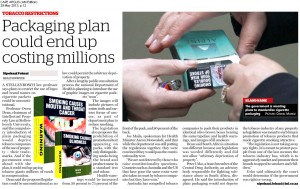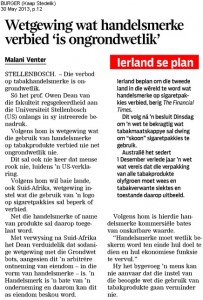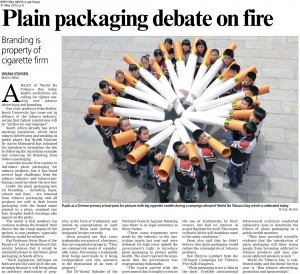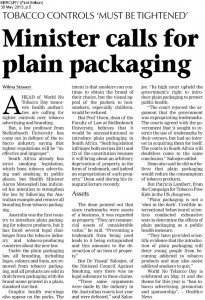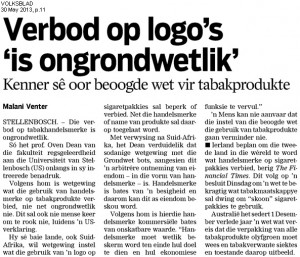South Africa is no stranger to the fever that accompanies the discovery of gemstones or precious metal in a particular region. Indeed, for decades the mineral riches of our nation were legendary across the world and the object of several battles for imperial, colonial or feudal control over the diamond, gold, platinum and coal fields of South Africa. As a testament to this, the foothills of Table Mountain is home to the Rhodes Memorial dedicated to the fervently imperialist, English mining magnate Cecil John Rhodes, former Prime Minister of the Cape Colony, founder of De Beers Consolidated Mines and, at the time of his death, one of the richest men in the world.
Today, despite the fact that 50% of the world’s gold deposits are to be found in South Africa, we are no longer the greatest gold producing country in the world. And yet we operate the two deepest mines in the world. Clearly we are prepared to go to extraordinary lengths to exploit our natural resources to the full extent.
Therefore, it follows that our Government should be well versed in the practice of protecting our national resources from exploitation by foreigners and alien encroachment. After all, a single region of the Western Cape is home to a greater diversity of flora than all of Western Europe. Consequently, one would be forgiven for thinking that Government is a zealous champion of our proudly South African exports.
Alas, this is not the case. ROOIBOS is a perfect case in point. For decades the Afrikaans word “rooibos” (meaning red bush) has been used to identify the dried leaves, infusions or extracts of the Aspalathus linearis plant indigenous to the fynbos area of the Western Cape. After it was discovered that ROOIBOS holds several health benefits over other teas due to its high level of natural antioxidants and lack of caffeine, as well as its therapeutic application to relieve tension, digestive disorder and allergies, ROOIBOS became popular the world over. This rise to fame was significantly aided by the South African owned Annique range of health and beauty products containing ROOIBOS as the primary ingredient, established as early as 1968.
However, 45 years later the SA Rooibos Council is still fighting an uphill battle to gain control over use of the name ROOIBOS. Recent reports in the media about a trade mark registration application for the name ROOIBOS in France by Compagnie de Trucy is only the latest in a long line of cases involving untoward prospecting.
At this point one might well ask; what will it take to stay the rush for South Africa’s indigenous resources?
Once again, the case of ROOIBOS provides an answer. Like many other herbal-derived products, ROOIBOS is used as an indication of the type and the origin of the product after the fashion of “Darjeeling” and “Ceylon”. Therefore, since trade marks serve as a badge of origin, it follows that trade mark registration offers a solution to the ROOIBOS problem. However, as the incumbent of this Chair has pointed out, ROOIBOS will likely fall foul of the test for a registerable trade mark because it is a generic English word incapable of distinguishing the product of one manufacturer from that of another. The same holds true for the ubiquitous “Chai” tea products.
Thus, if trade mark protection is likely unavailable, certainly the Department of Trade and Industry (DTI) should be able to bring to bear more powerful tools for the protection of uniquely South African products. The DTI is, after all, the Government body entrusted with all matters of intellectual property in South Africa and therefore expert in the field. Once again, alas no.
Even though South Africa is a signatory to the TRIPS agreement, through which most of the world must observe the protection of a product designated to a particular region (known as geographical indications or GI’s), the DTI and its inexpert advisors remained blissfully unaware of an intellectual property statute (introduced by the DTI itself) drafted for precisely this purpose. This statute, the Merchandise Marks Act of 1941, in section 15 provides for the protection of a mark or word through declaration by the Minister of Trade and Industry that, once made, provides the basis for protection of that mark as a GI everywhere in the world. In fact, a word or mark decreed under section 15 is granted far greater protection than under the Trade Marks Act, at no cost, in perpetuity, subject to criminal (as opposed to civil) sanction, far more expeditiously and beyond the scope of a mark used in the course of trade.
Therefore, clearly the ROOIBOS problem is solved. The law exists to protect it, it costs nothing and the DTI has the power to grant such protection. Once again, alas no. As with all matters in South Africa today, if there is no political advantage there is no political will. As a result, the DTI was informed of the mechanism created by the Merchandise Marks Act a decade ago and again recently by several national newspapers and even on national television by the incumbent of this Chair, Professor Owen Dean. And yet, the DTI did nothing.
Eventually, it took extraordinary and hereto unseen action by a member of the academic fraternity to spur the DTI into action. Earlier this year, Professor Dean met with Ambassador Roeland van de Geer, Head of the Delegation of the European Union to SA, and Mr Axel Pougin de la Maisonneuve, Head of the Political Economic and Trade Section of the EU Delegation, to discuss the ROOIBOS problem.
Upon learning about the nature of protection under the Merchandise Marks Act, and particularly the rigidity of protection it offers, Ambassador Van de Geer undertook to raise the matter with Dr Rob Davies, Minister of Trade and Industry.
Two months later, on 12 July 2013, South Africa finally staked its claim to the ROOIBOS name with the publication of notice 722 of 2013 in the Government Gazette (full text here ![]() ) in terms of the Merchandise Marks Act.
) in terms of the Merchandise Marks Act.
It was with great delight that this Chair received the news that, for once, the DTI respected its role as the guardian of intellectual property rights enough to heed the advise of intellectual property experts. The notice now lists ROOIBOS and 5 variations of the name as prohibited marks or words. These are: RED BUSH, ROOIBOSTEE, ROOBOS TEA, ROOITEE and ROOIBOSCH.
Any interested party may now submit comments or concerns about the envisioned protection with the Registrar of Trade Marks for 30 days. Thereafter, a promulgation period follows after which a final notice will be published to declare these terms prohibited words under the Merchandise Marks Act. (UPDATE: The period for commentary and promulgation has since been completed and the final notice published in the Government Gazette. See note at the end of this post for the full text).
Once this process is completed, hopefully by mid October, the use of these terms will be subject to the “Rules of Use for Rooibos” published along with the notice. These rules stipulate, in no uncertain terms, how ROOIBOS products should be identified and labelled. The guidelines also distinguish between pure ROOIBOS products, ROOIBOS blended teas or infusions, blended teas or infusions containing ROOIBOS, ROOIBOS flavoured teas or infusions with liquid flavours, and other products containing ROOIBOS. In all of these cases the SA Rooibos Council’s right to control the use of the term ROOIBOS is exerted with care and conspicuously circumscribed to permit all forms of legitimate use.
As a result, Ambassador Van de Geer indicated that under these circumstances the EU are likely to apply the same regulations to the GI specification description when the application for ROOIBOS is brought before the EU Commission and foresees that such protection will likely be extended to ROOIBOS. Once this process is complete, by operation of EC Regulation 510/2006, every member state of the EU would be obliged to refrain from using the ROOIBOS mark (or any of the other marks listed) without the express permission of the SA Rooibos Council and subject to the Rules of Use of Rooibos. This rule is known as the national treatment principle and requires every member state to provide the same level of protection to foreign GI’s as it affords to local products, regardless of whether a state of reciprocity exists or not. In addition, every trade mark registrar in Europe, including the pan-European trade mark office (OHIM), will be obliged to refuse the application for registration of any trade mark that contains any of the prohibited ROOIBOS word marks or derivatives thereof.
According to a report in The Guardian (25 July 2013), the ROOIBOS industry in South Africa is worth an estimated R600 million per annum, which equates to 0.6% of gold production in 2012. Impressive as this figure may be, it is obvious that ROOIBOS earnings would have been much higher had the DTI guarded our intellectual property fields as well as Government protects our gold fields. Fortunately, for the first time in a long time the hope exists that the DTI will take its mandate seriously. If it does, the future of “Karoo Lamb”, “Grabouw Boerewors” and “Kalahari Tea” (to name but a few) seem so much brighter.
The protection of ROOIBOS is certainly a victory over adversity and it has cleared a way through the minefield of burocratic lethargy and obstinate ignorance toward a new era of mining in South Africa.
The DTI should be commended for moving in support of the ROOIBOS industry and the protection of our indigenous resources. All that remains is the desire, so often expressed by this Chair and every other notable authority on intellectual property law, that the DTI will act in an equally sage manner regarding the Intellectual Property Laws Amendment Bill. After all, it is impossible to dig for gold with the aid of a spoon. An altogether more serious tool is required, which has been supplied in the form of the James/Dean Bill on the Protection of Traditional Knowledge. If ROOIBOS is anything to go by (and it clearly is) our indigenous resources run much deeper than mere cultural expressions and the hope is expressed that Government will be inspired by its success in this regard to carry on in the same, carefully informed, manner.
Cobus Jooste
UPDATE:
The final notice for the protection of ROOIBOS and related marks has since been published in the Government Gazette No. 36807, Notice 911 of 2013 (full text here ![]() ). Therefore, as of 6 September 2013, use of any of the listed terms is subject to the Rules of Use for Rooibos.
). Therefore, as of 6 September 2013, use of any of the listed terms is subject to the Rules of Use for Rooibos.
The first notice for the protection of HONEYBUSH / HEUNINGBOS and related marks has been published in the Government Gazette No. 36736, Notice 817 of 2013 (full text here ![]() ). The 30 day period for commentary has since lapsed, and the final notice will be published soon.
). The 30 day period for commentary has since lapsed, and the final notice will be published soon.

